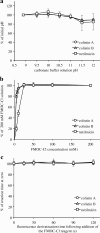Rapid, simple, and clinically applicable high-performance liquid chromatography method for clinical determination of plasma colistin concentrations
- PMID: 30151222
- PMCID: PMC6100703
- DOI: 10.1186/s40780-018-0119-x
Rapid, simple, and clinically applicable high-performance liquid chromatography method for clinical determination of plasma colistin concentrations
Abstract
Background: Since both the antibacterial effects and common adverse effects of colistin are concentration-dependent, determination of the most appropriate dosage regimen and administration method for colistin therapy is essential to ensure its efficacy and safety. We aimed to establish a rapid and simple high-performance liquid chromatography (HPLC)-based system for the clinical determination of colistin serum concentrations.
Methods: Extraction using a solid-phase C18 cartridge, derivatisation with 9-fluorenylmethyl chloroformate, and elution with a short reversed-phase Cl8 column effectively separated colistin from an internal standard. The HPLC apparatus and conditions were as follows: analytical column, Hydrosphere C18; sample injection volume, 50 μL; column temperature, 40 °C; detector, Shimadzu RF-5300 fluorescence spectrophotometer (excitation wavelength, 260 nm; emission wavelength, 315 nm); mobile phase, acetonitrile/tetrahydrofuran/distilled water (50,14,20, v/v/v); flow-rate, 1.6 mL/min.
Results: The calibration curves obtained for colistin were linear in the concentration range of 0.10-8.0 μg/mL. The regression equation was y = 0.6496× - 0.0141 (r2 = 0.9999). The limit of detection was ~ 0.025 μg/mL, and the assay intra- and inter-day precisions were 0.87-3.74% and 1.97-6.17%, respectively. The analytical peaks of colistin A, colistin B, and the internal standard were resolved with adequate peak symmetries, and their retention times were approximately 8.2, 6.8, and 5.4 min, respectively. Furthermore, the assay was successfully applied to quantify the plasma colistin levels of a haemodialysis patient.
Conclusion: The assay is a simple, rapid, accurate, selective, clinically applicable HPLC-based method for the quantification of colistin in human plasma.
Keywords: 9-fluorenylmethyl chloroformate; Colistin; Fluorescence detection; Haemodialysis; High-performance liquid chromatography; Therapeutic drug monitoring.
Conflict of interest statement
The study protocol was approved by the Research Ethics Committee of Toho University Omori Medical Center (Approval Number M17280).Not applicable.The authors declare that they have no competing interests.Springer Nature remains neutral with regard to jurisdictional claims in published maps and institutional affiliations.
Figures



Similar articles
-
A Rapid and Simple HPLC-MS/MS Method for the Quantitative Determination of Colistin for Therapeutic Drug Monitoring in Clinical Practice.Drug Des Devel Ther. 2024 Nov 1;18:4877-4887. doi: 10.2147/DDDT.S479329. eCollection 2024. Drug Des Devel Ther. 2024. PMID: 39502715 Free PMC article.
-
Development and validation of a high-performance liquid chromatography-fluorescence detection method for the accurate quantification of colistin in human plasma.J Chromatogr B Analyt Technol Biomed Life Sci. 2015 Feb 1;980:48-54. doi: 10.1016/j.jchromb.2014.12.015. Epub 2014 Dec 19. J Chromatogr B Analyt Technol Biomed Life Sci. 2015. PMID: 25589254
-
A simple method for the assay of colistin in human plasma, using pre-column derivatization with 9-fluorenylmethyl chloroformate in solid-phase extraction cartridges and reversed-phase high-performance liquid chromatography.J Chromatogr B Biomed Sci Appl. 2001 Sep 25;761(2):167-75. doi: 10.1016/s0378-4347(01)00326-7. J Chromatogr B Biomed Sci Appl. 2001. PMID: 11587346
-
Determination of concentrations of flecainide in human serum by high-performance liquid chromatography on a fluorocarbon-bonded silica gel column.J Chromatogr B Biomed Sci Appl. 1999 Apr 16;726(1-2):219-23. doi: 10.1016/s0378-4347(98)00578-7. J Chromatogr B Biomed Sci Appl. 1999. PMID: 10348189
-
High-throughput hydrophilic interaction chromatography coupled to tandem mass spectrometry for the optimized quantification of the anti-Gram-negatives antibiotic colistin A/B and its pro-drug colistimethate.J Chromatogr A. 2014 Nov 21;1369:52-63. doi: 10.1016/j.chroma.2014.09.063. Epub 2014 Oct 2. J Chromatogr A. 2014. PMID: 25441071
Cited by
-
A Rapid and Simple HPLC-MS/MS Method for the Quantitative Determination of Colistin for Therapeutic Drug Monitoring in Clinical Practice.Drug Des Devel Ther. 2024 Nov 1;18:4877-4887. doi: 10.2147/DDDT.S479329. eCollection 2024. Drug Des Devel Ther. 2024. PMID: 39502715 Free PMC article.
-
New validated spectrofluorimetric protocol for colistin assay through condensation with 2,2-dihydroxyindan-1,3-dione: application to content uniformity testing.RSC Adv. 2022 Nov 23;12(52):33559-33566. doi: 10.1039/d2ra04259b. eCollection 2022 Nov 22. RSC Adv. 2022. PMID: 36505680 Free PMC article.
-
Method development for simultaneous estimation of Amlodipine Besylate and Perindopril Tertbutyl amine in fixed-dose.Heliyon. 2023 Mar 1;9(3):e14209. doi: 10.1016/j.heliyon.2023.e14209. eCollection 2023 Mar. Heliyon. 2023. PMID: 36923897 Free PMC article.
-
A physicochemical assessment of the thermal stability of dextrin-colistin conjugates.Sci Rep. 2021 May 19;11(1):10600. doi: 10.1038/s41598-021-89946-2. Sci Rep. 2021. PMID: 34011987 Free PMC article.
-
Combining Metabolomics and Experimental Evolution Reveals Key Mechanisms Underlying Longevity Differences in Laboratory Evolved Drosophila melanogaster Populations.Int J Mol Sci. 2022 Jan 19;23(3):1067. doi: 10.3390/ijms23031067. Int J Mol Sci. 2022. PMID: 35162994 Free PMC article.
References
-
- Koyama Y, Kurosasa A, Tsuchiya A, Takakuta K. A new antibiotic “colistin” produced by spore-forming soil bacteria. J Antibiot (Tokyo) 1950;3:457–458.
-
- Berlana D, Llop JM, Fort E, Badia MB, Jodar R. Use of colistin in the treatment of multiple-drug-resistant gram-negative infections. Am J Health Syst Pharm. 2005;62:39–47. - PubMed
LinkOut - more resources
Full Text Sources
Other Literature Sources

